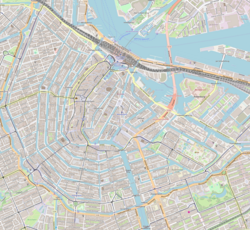Museum Fodor

Museum Fodor in 1970
|
|
|
Location in the city center pf Amsterdam
|
|
| Established | 1863 |
|---|---|
| Dissolved | 1 January 1993 |
| Location |
Keizersgracht 609 Amsterdam, Netherlands |
| Coordinates | 52°21′50″N 4°53′37″E / 52.36389°N 4.89361°ECoordinates: 52°21′50″N 4°53′37″E / 52.36389°N 4.89361°E |
| Type | Art museum |
| Founder | Carel Joseph Fodor |
Museum Fodor (Dutch pronunciation: [myˈzeːjɵm ˈfoːdɔr]) is a former art museum in Amsterdam in the Netherlands. The museum was located at the Keizersgracht in Amsterdam-Centrum in the building that currently houses the Foam Fotografiemuseum Amsterdam.
The museum was opened in 1863. It was founded following the death of Carel Joseph Fodor and displayed his art collection. The museum was dissolved in 1993. Fodor's collection is now managed by the Amsterdam Museum.
The monumental building on the Keizersgracht canal has a history going back to Carel Joseph Fodor (1801–1860), who worked in the coal trading business. Carel Fodor first bought the Keizersgracht 611. Later he also bought the adjacent warehouse and residential house.
Fodor started to collect paintings, drawings and prints from 1834 onwards. His preference went out to contemporary art, works by 'living masters'. Fodor quickly opened up his house to the general public, where many art lovers visited to see his collection by appointment.
When Fodor died, he bequeathed his collection to the city of Amsterdam. He also left behind a large sum of money to turn his house into a museum. Fodor destined Keizersgracht 609, the warehouse, in his testament as the exhibition space that should receive the name Museum Fodor. It should become a permanent exhibition space for his personal collection.
The building was renovated in 1861 by Cornelis Oudhoorn. In 1863, Museum Fodor opened its doors as the first museum of modern art. In the early years the museum attracted a large number of visitors, but as the years passed by these numbers dwindled.
In 1948 the collection was stored in a depot and the museum became a separate location of the Stedelijk Museum. In 1963 the complete collection was taken over by the Amsterdams Historisch Museum.
...
Wikipedia

